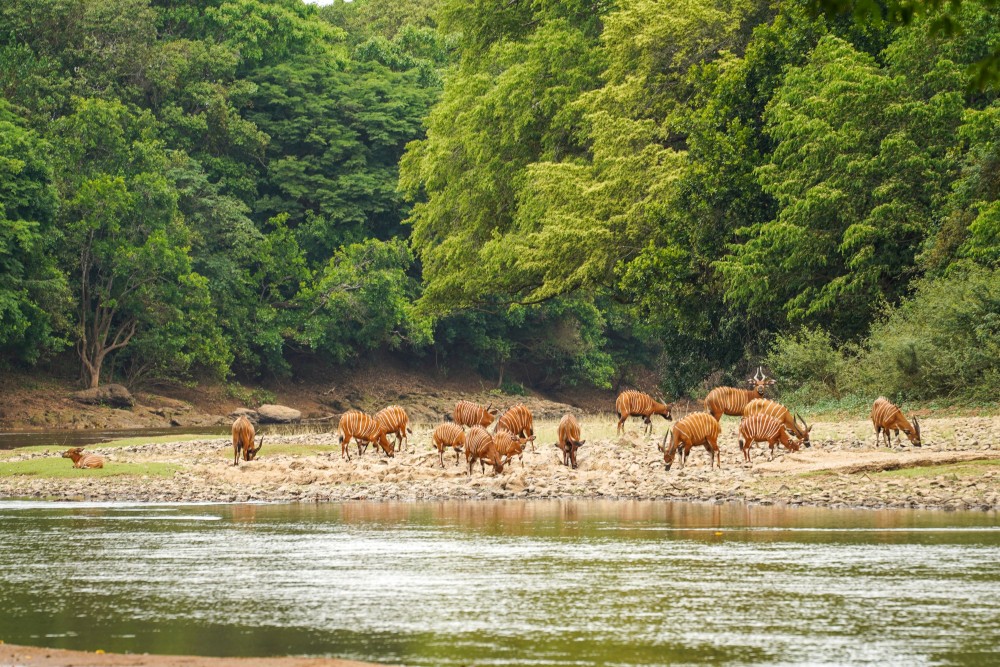About Chinko
Chinko is in an area that comprises around 107,500 km2 of continuous wilderness comprising savannah and tropical forest, mixed habitats that have resulted in extraordinary wildlife diversity. Remarkably, despite decades of instability and poaching, the ecosystem has largely remained intact with remnant populations of key species. With a sound conservation and management approach, security within Chinko’s core area has been established, and wildlife numbers are stabilising and increasing. As we begin to understand this largely under researched area, a rich diversity of species are being documented.
Chinko is one of the only protected areas in the world where both forest and savannah elephant coexist. With around 1,500 giant eland (Tragelaphus derbianus), also known as Lord Derby eland, in its core zone, Chinko’s growing population makes it a stronghold for the species.
The most recent surveys (2022) have indicated that Chinko has the following:
- An estimated 100 forest elephant
- 25 carnivore species, including 10 packs of the endangered African wild dog, and about over 100 northern lion
- 14 primate species, including approximately 1,300 eastern chimpanzees
- 24 species of even-toed ungulates including approximately 1,500 eastern giant eland, 6,000 African buffalo, 1,400 roan antelope, 1,400 bongo, 1,600 defassa waterbuck, and eight different species of duiker
- 3 species of African pangolin confirmed
Monitoring and Surveys

Continuous biological monitoring is being implemented to document the recovery of key wildlife populations. A wildlife population survey in 2021 showed a steady recovery of most key wildlife populations, while camera trap survey results in 2022 observed relaxed elephant behaviour and 11 wild dogs with juveniles. In northern Chinko, a breeding population of eastern chimpanzee was confirmed through camera trap observations and vocalisations. This significant finding has increased the known distribution range of chimpanzee in the eastern CAR wilderness.
Chinko’s first lion was collared in 2022, to better understand the northern lion population, and teams confirmed the first documented evidence of a striped hyaena in CAR.
Conservation Law Enforcement
Chinko operates in a complex environment that must consider not only direct threats to conservation, but also regional insecurity, a complex governance environment, and high levels of poverty among both sedentary and nomadic populations in the periphery. Protecting the park, its wildlife, and surrounding communities go hand in hand in helping the long-term viability of the entire area.
Rangers regularly undergo leadership training, with lectures on conservation law enforcement, biodiversity and first aid. In 2022, the team increased its active protection of the core protected area to 24,300 km2, keeping the area free of livestock. A local human rights point person was also recruited and conducted training. Through extensive tracking and surveillance within Chinko, 60 ECHO monitors document wildlife populations and habitats, and actively manage the fringes of the park, interacting with local hunters, fishermen, miners, honey gatherers, loggers and other members of settled communities.
Since 2016, TANGO teams – Transhumance Sensitisation Officers engaged from local communities – have engaged with transhumance herders coming into CAR from Sudan, preventing them from driving cattle through Chinko by guiding them towards designated corridors to avoid sensitive wildlife habitats. During the transhumance season, TANGO teams spend up to six months in the field on the periphery of the protected area, raising awareness of the value of conservation, and promoting a sustainable grazing approach. This creative solution also fosters peaceful coexistence between nomadic pastoralists and sedentary communities in eastern CAR.
